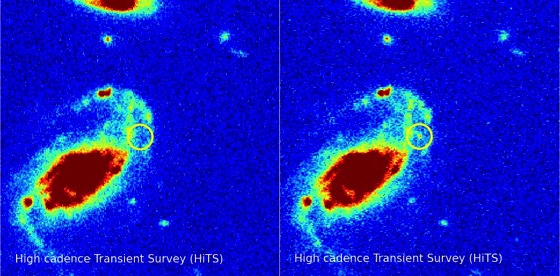
A group of scientists and researchers from the Center for Mathematical Modeling at Universidad de Chile (CMM) saw 61 supernova explosions in real-time only hours after they appeared in the sky.
The multidisciplinary team led by astronomer Francisco Förster did a similar experiment during five nights in 2014. In that moment, they found 12 of these stars that can be seen in the sky for a limited amount of time. This kind of studies gives information about phenomena related to the evolution and chemical enrichment of the universe and of its celestial bodies, among other issues.
“You can search supernovae to measure distances and with that information determine the expansion of the Universe. Or to understand how the elements of the universe have been created. For example, the Sun could be a product of these explosions. Our objective, particularly, is to understand the supernova’s progenitor star: what kind of star gave origin to the explosion,” explained Förster, who stresses the that just one supernova is produced every 100 years in every galaxy. For that reason, finding one is an event of extremely low probability.
The monitoring from Cerro Tololo Observatory used the Dark Energy Camera (DECam) of 520 megapixels to take pictures from the space. “It is the second best camera in the world for this kind of data survey of the sky,” said the astronomer.
The images were sent for almost 500 kilometers through the high-speed Reuna optic fiber network to the second most powerful Latin American supercomputer in the National Laboratory of High Performance Computing at the CMM in Santiago. This machine had a software program created by Förster and his team, which analyzed the data with an algorithm. This algorithm was created in 2013 and updated in 2014, after the first survey campaign. The improvements in this mathematical model allowed increasing five times the number of detected supernovae this year.

“You have to teach to the computer to recognize stars. You show it millions of examples and the computer learns. This is called Machine Learning,” said Förster.
Basically, the software compares different pictures from the space and examine where supernovae are. When it finds them, it sends a global alert to observatories, so they can point their telescopes to the new event. In the past, this work was handmade and, since the 90s, with digital detectors. Today, this mathematical modeling analyzed almost one hundred thousand of images, which are equivalent to one thousand billion of pixels shot during six nights of eight hours of exploration.
The group also detected asteroids, stars and other non-classified objects.
Telegrams
http://www.astronomerstelegram.org/?read=7149
http://www.astronomerstelegram.org/?read=7148
http://www.astronomerstelegram.org/?read=7146
http://www.astronomerstelegram.org/?read=7131
http://www.astronomerstelegram.org/?read=7122
http://www.astronomerstelegram.org/?read=7115
http://www.astronomerstelegram.org/?read=7108




 Noticias en español
Noticias en español
